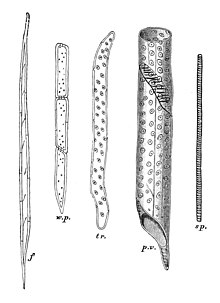Xylem
Xylem is a tissue in vascular plants. Its cells have thick, hard walls. Xylem tissue dies soon after it is formed and is the wood in the middle of a tree. The dead cells are like pipes, hollow and rigid.


Xylem is one of two tissues in the plant which transport substances that plants need to live. Substances that xylem transports include water and minerals obtained through the plant's roots, as xylem runs from the roots to the stems and leaves. The other transport tissue is the phloem, which transports energy in the form of sugar (as well as any other chemicals) from the leaves to the rest of the plant.
Xylem cells are present in all parts of a plant, in stems, roots, and leaves. Water is carried against gravity by the negative pressure that builds up through the process of transpiration, which is the evaporation of moisture in leaves.
Xylem consists of four types of cells:
- Xylem parenchyma which are living cells with thin walls
- Xylem fibres
- Tracheids
- Xylem vessels
Most of these cells are dead cells and have thick walls.